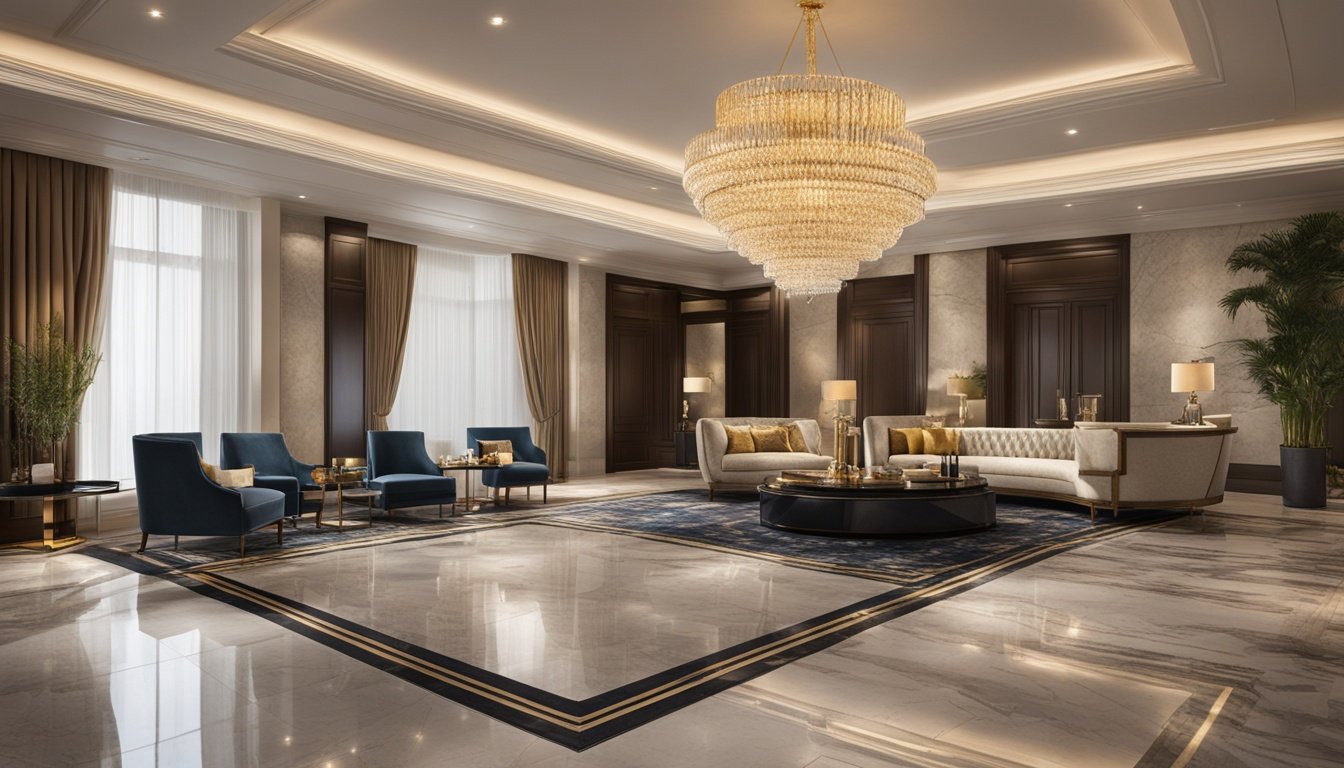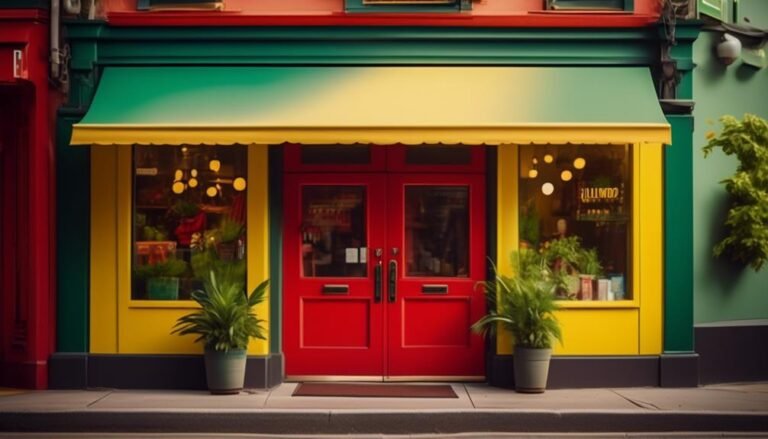Applying Maslow’s Hierarchy to Luxury Brands
Did you know personalized marketing can boost customer engagement by up to 50%? In the luxury world, understanding what drives customers is key. Brands use frameworks like Maslow’s Hierarchy of Needs to craft their marketing. They aim to match the dreams of their customers with their products.
Today, big names like Gucci and Louis Vuitton offer more than just products. They create experiences that touch on every level of need, from basic to reaching our highest goals.
The luxury market has changed a lot over the years. Now, over 2,200 Zara stores worldwide show how fast fashion trends change. But luxury brands focus on keeping production close to where they design, in places like Italy and France. This ensures top-notch quality.
Louis Vuitton, for example, makes everything from fabric to retail, controlling their luxury brand marketing perfectly.
By matching their brand with Maslow’s Hierarchy of Needs, luxury brands build stronger emotional bonds with customers. They use unique items and famous people to show they understand what people want.
Key Takeaways
- Personalized marketing can boost customer engagement by up to 50%.
- Vertical integration enhances quality control from fabric creation to retailing.
- Exclusive offerings and made-to-measure services increase customer loyalty.
- Trigger events and buyer personas shaped by Maslow’s hierarchy guide effective marketing strategies.
- Alignment with consumer psychological needs helps brands navigate economic uncertainties effectively.
Introduction to Maslow’s Hierarchy of Needs
American psychologist Abraham Maslow introduced Maslow’s Hierarchy of Needs in 1943. This framework helps us understand what drives humans. It’s like a pyramid with five levels, from basic to complex needs for happiness.
At the bottom, we find basic needs like air, food, drink, and shelter. Maslow says we must meet these needs first. Then, we can move on to safety needs, which are about having order and control in life.
Social needs come next, focusing on love, belonging, and relationships. These are key for luxury brands to connect with consumers. Esteem needs follow, covering self-worth and respect, which affects how we see luxury brands.
At the top, self-actualization is about personal growth and reaching our full potential. Luxury brands might use AI to understand and meet these needs better.
Brands need to understand this hierarchy to market effectively. It shows how consumer behavior changes over time, affecting what we buy and our loyalty to brands. By knowing this, luxury brands can speak to their audience’s needs, especially in tough times.
Understanding Consumer Psychology in Luxury Branding
Understanding what drives people to buy luxury is key for brands. By looking into luxury purchase motivation, brands can make strategies that connect with their audience. Maslow’s theory helps us see why people want luxury, from basic needs to deeper desires.
The Foundation of Maslow’s Theory
Maslow’s hierarchy shows a journey from basic needs like food to higher desires like self-esteem. Luxury brands can aim at these needs to reach their audience. Research shows that emotions and feelings influence 86% of buying decisions.
Consumer Behavior and Luxury Purchases
Buying luxury is complex, showing both personal and social changes. People are ready to pay more for luxury that shows who they are. This fits with Maslow’s higher needs, like self-expression and self-esteem.
By focusing on these needs, luxury brands can build a loyal customer base. Knowing what consumers want can increase brand loyalty by 20%. Personalized luxury experiences can make customers 30% happier. This shows how important it is to use consumer psychology in luxury branding.
“Targeting the emotional brain can increase consumer spend by almost 200% in some cases.”
The Role of Physiological Needs in Luxury Branding
In luxury branding, meeting physiological needs means offering top-quality products. These products must show great craftsmanship. This is key to meeting what consumers expect in fashion. It turns buying into a fulfilling experience, matching what people think and making the brand stand out.
Meeting Basic Consumer Expectations
Luxury brands meet physiological needs by using the best materials and skills. This focus on details sets a high standard of luxury. For instance, brands like Chanel and Louis Vuitton show off their craftsmanship and material quality.
Keeping up a high quality level is key to meeting needs. Studies show that high-end shoppers want nothing but the best. Luxury brands must keep innovating and maintaining high standards to meet these expectations.
Building a Strong Brand Foundation
Quality products build a strong brand foundation for long-term success. Brands that consistently meet needs gain loyal customers who trust their products. This trust is vital in the luxury market where expectations are very high.
Labels like “Made in Italy” or “Made in France” mean excellent craftsmanship and quality. This reputation helps luxury brands build loyalty and prestige. It creates a strong base for further growth.
Meeting physiological needs with unmatched quality is crucial for luxury brands. It helps them meet consumer expectations and build strong loyalty.
Addressing Safety Needs Through Premium Positioning
In the world of luxury brands, making sure they are safe and secure is key. By focusing on being top-quality, these brands build trust with their customers. This is crucial for meeting the safety needs as seen in Maslow’s hierarchy of needs.
Brands like Gucci, Versace, Yves Saint Laurent, and Ralph Lauren work hard to keep their quality high. They make sure their products last a long time. This makes customers feel secure about their purchases and value the luxury they offer.
In the luxury car market, brands aim at people who have moved past basic needs. They offer more than just a car; they promise dependability and status. This promise is clear in their ongoing efforts to keep luxury brands safe and secure.
Companies like Viking Cruises and Abercrombie and Kent offer unique experiences. They focus on being the best in their field. These experiences meet the needs of customers looking for both safety and trust in luxury brands.
To sum up, luxury brands meet their customers’ safety needs by offering top-quality products and being a trusted brand. This not only builds trust but also keeps the brand as a top choice in the market.
Belongingness and Love: Creating Emotional Connections
Luxury brands focus on building strong emotional ties with customers. They aim to meet the deeper needs of belongingness and love. This approach helps create lasting relationships with their audience.
The Importance of Brand Loyalty
Brand loyalty in high-end markets means more than just buying again. It’s about having a loyal customer base that truly connects with the brand. Brands like Rolex and Chanel make customers feel they belong to an exclusive group.
This feeling of belonging helps keep customers coming back. It also helps the brand stay strong in the market and make more money.
Community Building in the Luxury Market
Building luxury brand communities is a great way to strengthen ties with customers. These communities let customers share stories, join special events, and connect with the brand more closely. For example, Lamborghini hosts private events for owners, building a strong sense of community and loyalty.
Unique Customer Experience
Offering a special experience is key to building emotional bonds with customers. Brands like Hermes and Louis Vuitton provide services that are made just for each customer. This makes customers feel special and valued.
By focusing on these personal connections, luxury brands can turn simple purchases into unforgettable moments. This approach boosts brand loyalty in high-end markets and makes the brand unforgettable to its customers.
Applying Maslow’s Hierarchy to Luxury Brands
Luxury brands use Maslow’s Hierarchy to connect with what consumers feel and think. Many luxury brands have seen great success with this method.
Case Studies of Successful Brands
Hermés and their Birkin bag are a great example. They use *Maslow’s Hierarchy* in their branding. By making the bag hard to get, they make it more special. This meets consumers’ need for status and recognition.
It’s not just about selling a product. It’s about offering a lifestyle that people want to achieve.
The Impact of Exclusivity and Accessibility
Being able to get luxury items drives consumer behavior. Brands like Louis Vuitton and Rolex control how much is available. This keeps people wanting more.
These brands meet needs like self-actualization and esteem. They balance being exclusive with being reachable. This makes them a goal for those looking to grow and improve their status.
Luxury brands build a community and loyalty with their fans. They do deep research and carefully choose what they offer. This keeps them interesting and relevant, meeting consumers’ needs and desires.
Esteem Needs: Elevating Status Through Luxury
Luxury brands tap into our deep desire for status and respect. They offer symbols of prestige that match our dreams of being more respected. Brands like Apple make their products seem like a must-have for success.
Status Symbols and Brand Prestige
Luxury items are seen as symbols of high social standing. They make the owner look better in the eyes of others. Brands like Rolex and Chanel know this well, making their products symbols of success.
The magic of a Rolex or Chanel bag isn’t just in how it’s made. It’s also in the status it gives to the owner. This link between luxury and social standing makes people want these products.
The Role of Influencers and Celebrities
Influencers and celebrities play a big part in luxury branding. When a famous person uses a brand, it makes people want it more. It links the product to the star’s success and lifestyle.
For example, James Bond wearing an Omega watch makes it seem cool. This boosts the brand’s image and meets our need for respect and admiration.
By using celebrity power, brands can make luxury goods more appealing. They connect with our dreams of being more respected and admired.
Achieving Self-Actualization with High-End Brands
High-end brands can meet consumers’ deep needs by matching with their growth and dreams. It’s key to grasp the role of *self-actualization in luxury branding*. This connection makes brands more meaningful to people.
Personal Growth and Luxury Purchases
Personal growth is big in luxury buying. Maslow’s Hierarchy of Needs shows self-actualization as the top level. It’s about reaching one’s full potential. Luxury items like fancy cars, designer clothes, and luxury watches show off personal success and achievement.
Loyal luxury customers look for brands that match their dreams for growth and *personal growth in luxury markets*. Brands like Nike and Apple use self-actualization in their ads. They connect with consumers’ dreams for betterment and excellence.
Aspiration as a Marketing Tool
Aspirational marketing uses the wish for self-actualization to make consumers dream big with the brand. It’s about real customer connections, telling stories with heart, and offering special experiences. These are ways marketers can speak to these consumers.
Quality, new ideas, and celebrating being unique draw in self-actualized buyers. Being ethical and sustainable is also key. It shows a brand cares about the world and its impact.
Brands that get and meet the dreams of self-actualized buyers can build stronger bonds. This can lead to more loyalty and engagement in the market.
The Impact of Digital Transformation on Luxury Brands
The digital world has changed how luxury brands work and connect with people. Now, they’re looking into virtual luxury with NFTs and the metaverse. They’re also using omnichannel strategies for a smooth experience across different platforms.
Virtual Luxury: NFTs and the Metaverse
NFTs have opened new doors for luxury fashion brands online. They let brands offer special digital items that appeal to tech-savvy buyers. The metaverse is also key, offering a place for people to buy unique virtual goods. This move fits with the shift to digital and meets consumers’ wants for something special.
In 2019, there were about 5.11 billion unique mobile users worldwide. This shows how crucial mobile-friendly experiences are. Luxury shoppers, who are often on social media, have grown more connected. Influencer marketing has also grown a lot, showing the potential for NFTs in luxury fashion on social media.
Omnichannel Strategies
For luxury brands, having a good omnichannel strategy is key. They need to be present across digital and physical places. By 2025, 20% of luxury sales are expected to happen online, so a smooth online and offline experience is crucial.
Brands that connect well with customers across channels do better. These customers buy more often and spend more each time. People of all ages spend a lot of time online, giving brands a chance to reach them. Online research also affects in-store purchases, with most luxury sales influenced by digital info.
In summary, combining virtual luxury like NFTs with strong omnichannel strategies is vital for luxury brands. As people look for more in the digital world, brands need to keep up with these changes to meet their needs.
Building Brand Stories: The DNA of Luxury Brands
Luxury brands have a special story, history, and DNA that speaks to people’s desire for status and self-expression. By telling their brand story, luxury brands connect with customers on a deeper level. This bond is key to their identity and makes them stand out.
Brands like Faberge and Noir show how to keep their founders’ vision alive while meeting today’s needs. They keep their core values, making their brand identity strong and appealing to today’s consumers. Research at Regent’s University London shows how these brands mix their history with modern corporate social responsibility.
Studies show that luxury brands can form a strong emotional connection with people by sharing their true stories. This connection grows stronger with strategic partnerships in corporate social responsibility. Experts like Porter & Kramer (2006) and Kathuria (2013) talk about the value of shared values and the challenges luxury brands face in CSR.
Luxury brands must balance their heritage with modern values to stay relevant and wanted. This balance keeps them appealing to their customers. For example, following ISO26000:2010 standards and Bob Willard’s five-stage sustainability journey can make their stories more real.
By doing this, luxury brands stay desirable and help society. The key to their success is telling stories that respect the past but look to the future. This careful handling of their heritage makes them truly special and exclusive.
Challenges and Strategies in Modern Luxury Branding
In today’s fast-changing market, luxury brands must adapt to stay ahead. They need to understand the market and what customers want without losing their unique edge.
Navigating Economic Uncertainties
Luxury brands face ups and downs in the economy. To overcome these, they use smart luxury market strategies. This includes flexible pricing and offering a variety of products.
During tough times, brands show off the lasting value of luxury. This keeps customers loyal. They also reach out to new markets with special luxury items to grow even when sales are down in other areas.
Maintaining Exclusivity and Scarcity
Keeping luxury brands exclusive is key. This means carefully controlling how much they make and offering unique services. Brands like Hermès and Rolls-Royce do this well by making sure they don’t make too much and focus on top-notch quality.
This approach keeps the brand’s prestige high and makes customers want it more because it’s rare. Managing where products are sold is also important to keep the brand’s value strong. Online platforms are tricky but can help target customers well and build strong relationships with them.
Using new luxury market strategies like special collaborations and limited editions helps create buzz. This keeps the brand exciting for both current and future customers.
Future Trends in Luxury Branding
The world of luxury branding is changing fast. Now, making things personal, being green, and using digital tools are key. Brands must keep up with evolving consumer expectations by using innovative luxury strategies.
Technology is a big deal in the future luxury brand trends. Things like virtual reality try-ons and AI advice will soon be common. These tech tools help brands connect better with customers by making things more personal.
Being green is a must. People want luxury brands to be eco-friendly and ethical. Brands like Hermès and Dior stay popular by focusing on quality and being open about their practices.
Now, it’s all about experiences, not just products. People want to have unique experiences with brands. This means marketing that offers special events and exclusive memberships is key. Brands need to create experiences that really speak to their customers.
The economy also affects luxury brands. A small group of wealthy customers drives a lot of sales. Brands need to focus on these customers with special offers. At the same time, new markets in places like China offer more chances to grow.
As luxury brands face these changes, being able to adapt and innovate is crucial. Brands that meet evolving consumer expectations and use innovative luxury strategies will lead the way. They set the standard for others.
Conclusion
As we wrap up our look at Maslow’s Hierarchy of Needs in luxury brands, it’s clear this theory is key. It helps us understand and shape how people act in this market. Abraham Maslow’s Hierarchy sorts human drives into five main levels: Physiological, Safety, Love/Belonging, Esteem, and Self-Actualization.
This framework gives luxury brands a clear way to bond with their audience. They start by meeting basic needs and then move to making customers feel secure. This builds loyalty, which is vital for growing a brand’s value over time.
Creating emotional bonds and offering special communities takes a brand higher. Focusing on esteem needs, like status symbols and influencer endorsements, meets consumers’ wants for recognition. Lastly, luxury brands tap into self-actualization by offering products that help people grow personally.
In a world where trends change fast due to society and tech, luxury brands must keep up and innovate. Using applied psychology in marketing is key. It helps brands meet these changing needs, keeping customers loyal and boosting brand value. The path from basic needs to self-actualization is what makes luxury brands truly special, keeping them relevant in the market.
Source Links
- TFR | Strategy Consulting Maslow, evolution and Luxury Fashion
- Applying Maslow’s Hierarchy of Needs in Marketing
- Breaking the Pyramid: Rethinking Maslow’s Hierarchy of Needs in Modern Marketing
- Maslow’s Hierarchy Of Needs In Consumer Behaviour
- Marketing Theories – Maslow’s Hierarchy of Needs
- No title found
- Maslow’s Pyramid and Purchasing Motivation – Consumer Psychology – Copymate
- Council Post: Are You Using Maslow’s Hierarchy Of Needs For Your Marketing?
- Fashion Psychology|Using Maslow’s Hierarchy of Needs Theory in Metaverse
- Hierarchy of Needs – Adogy
- Using Maslow’s Hierarchy to Reach Out to Customers
- Maslow’s Hierarchy of Needs & Theory of Motivation – Lesson | Study.com
- How to Apply Maslows Hierarchy of Need in Our Lives?
- Maslows Hierarchy Of Needs And Behavioral Segmentation – FasterCapital
- In Love With Your Brand: The Psychology of Brand Loyalty
- 6 Rules of Product Design According to Maslow’s Hierarchy of Needs
- The Importance of Maslow’s Pyramid of Needs – The School of Life
- Maslow’s Hierarchy of Needs: A Marketing Perspective
- Anwendung der Maslowschen Bedürfnishierarchie im Marketing
- From Physiological to Self-Actualization: Applying Maslow’s Theory in Marketing
- Maslow’s Hierarchy of Needs: How It Can Help Your Marketing
- Leveraging Self-Actualization in Marketing –
- LUXURY BRANDS EMBRACING THE RISE OF DIGITAL TO REMAIN A DISRUPTIVE PLAYER ON THE MARKET
- Intrinsic motivation of luxury consumers in an emerging market
- Maslow’s Hierarchy helps understand consumer needs
- Why high fashion brands don’t have the luxury of ‘eating the rich’
- The Fashion Pyramid of Brands (2024 Edition)
- Maslow’s Hierarchy of Needs and Marketing
- Motivation – Applying Maslow’s Hierarchy of Needs Theory – Management is a Journey®
- 9 Ways to Applying Maslows Hierarchy of Needs in Our Daily Lives | Mr. Business Magazine







